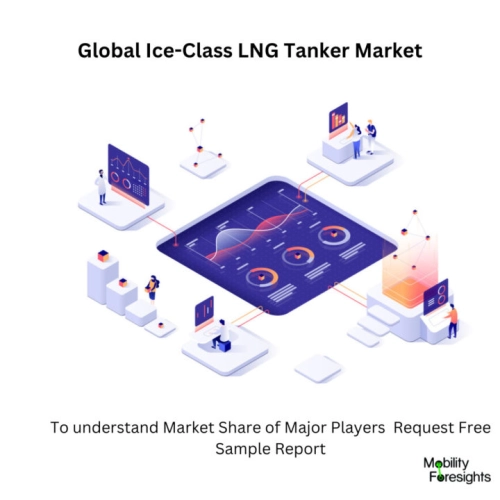
- Get in Touch with Us

Last Updated: Apr 26, 2025 | Study Period: 2023-2030
An Ice-class LNG carrier is atankshipdesigned for transportingliquefiednaturalgas(LNG). It is a highly-sophisticated gas carrier with very specialized LNG cargo containment system built for transportation of natural gases in bulk. As it is usual with LNG tankers, the cargo is transported at a temperature of minus one hundred and sixty degree celsius.
One of the main requirement of ice-class LNG carriers has been the need to use the boil-off gas from the cargo in the propulsion system. Steam turbine was used as a prime mover and steam was generated by boilers burning oil or boil-off gas, or the combination of both.
This type of propulsion is relatively inefficient and expensive to operate compared to diesel engines, especially when challenged by dual-fuel diesel-electric propulsion concept developed lately by Wärtsilä.
The move away from steam turbines to diesel engines is the biggest step since a long time. Today many new ice-class LNG carriers on order will be powered either by boil-off gas driving diesel-electric installation, with dual fuel arrangements for the passage with no gas on board, or large two-stroke diesel engines burning conventional fuel, with their boil-off gas reliquefied on board.

The Global ice-class LNG tanker market accounted for $XX Billion in 2022 and is anticipated to reach $XX Billion by 2030, registering a CAGR of XX% from 2023 to 2030.
Arc7 Ice-Class LNG Tankers, Russia
Russian shipbuilding company, Zvezda Shipbuilding Complex, is building a series of 15 next-generation Arc7 ice-class liquefied natural gas (LNG) tankers, for PJSC Novatekâs Arctic LNG 2 project in Gydan Peninsula in northern Siberia, Russia.
The Arc7 ice-class LNG tanker fleet will form the core of the Arctic fleet to transport LNG from the Arctic LNG 2 project, and ensure year-round navigation along the Northern Sea Route, including its Eastern section, throughout the year. The vessels will supply LNG to the Asian Pacific region and boost the development of the Russian shipbuilding industry.
The new LNG tankers will have increased icebreaking and manoeuvring characteristics, compared to the existing fleet used by Novatekâs Yamal LNG project. The carriers will be registered under the Russian Federation and operated by a Russian crew.
TheLNGcarriersare being built at the Zvezda Shipbuilding Complex, in the Russian Far East. The ships will be delivered to Arctic LNG 2 under long-term charter agreements with Smart LNG and Sovcomflot.
The construction of the Arc7 ice-class LNG tanker is significantly challenging, as the construction of Arctic class gas carrier vessels is a technologically complex process in the shipbuilding industry.
The Zvezda Shipyard Complex is the first company to undertake the construction of liquefied gas tankers in Russia.Zvezda will utilise equipment specific to Russian shipyards and the latest technologies for the construction of Arc7 ice-class tanker. The first part of the Arc7 ice-class tanker under construction was cut in the hull production unit, using a high-tech plasma-cutting machine.
| Sl no | Topic |
| 1 | Market Segmentation |
| 2 | Scope of the report |
| 3 | Abbreviations |
| 4 | Research Methodology |
| 5 | Executive Summary |
| 6 | Introdauction |
| 7 | Insights from Industry stakeholders |
| 8 | Cost breakdown of Product by sub-components and average profit margin |
| 9 | Disruptive innovation in theIndustry |
| 10 | Technology trends in the Industry |
| 11 | Consumer trends in the industry |
| 12 | Recent Production Milestones |
| 13 | Component Manufacturing in US, EU and China |
| 14 | COVID-19 impact on overall market |
| 15 | COVID-19 impact on Production of components |
| 16 | COVID-19 impact on Point of sale |
| 17 | Market Segmentation, Dynamics and Forecast by Geography, 2023-2030 |
| 18 | Market Segmentation, Dynamics and Forecast by Product Type, 2023-2030 |
| 19 | Market Segmentation, Dynamics and Forecast by Application, 2023-2030 |
| 20 | Market Segmentation, Dynamics and Forecast by End use, 2023-2030 |
| 21 | Product installation rate by OEM, 2023 |
| 22 | Incline/Decline in Average B-2-B selling price in past 5 years |
| 23 | Competition from substitute products |
| 24 | Gross margin and average profitability of suppliers |
| 25 | New product development in past 12 months |
| 26 | M&A in past 12 months |
| 27 | Growth strategy of leading players |
| 28 | Market share of vendors, 2023 |
| 29 | Company Profiles |
| 30 | Unmet needs and opportunity for new suppliers |
| 31 | Conclusion |
| 32 | Appendix |